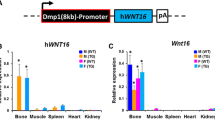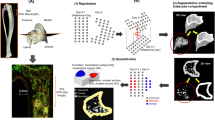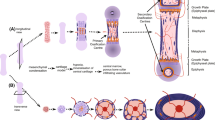Abstract
We here describe the novel high bone mass phenotype in STR/ort mice that leads to increased bone masses of cortical and trabecular bone and is associated with elevated osteoblast activity and impaired osteoclast function alike. Comparison of STR/ort and C57BL/6 mice reveals an increase in trabecular bone volumes of the vertebrae and at femoral metaphysis. In the females, this difference is significant as early as 2 months of age and at 9 months the females by far exceed their age matched males in all parameters measured. The increase in cortical bone mass at femoral diaphysis results from an apposition to the endosteal surface, it is significant for both sexes as early as 1 month of age and leads to bone marrow compression and extramedullary hematopoiesis. Altered activities of both, the osteoblast and the osteoclast contribute to the high bone mass and collectively this phenotype supports a multifactorial pathogenesis. Moreover, the spontaneous development of osteoarthritis in male STR/ort mice is suggestive of a tight correlation between trabecular bone mass and the development of degenerative changes of the articular cartilage.




Similar content being viewed by others
References
Teitelbaum SL, Ross FP (2003) Genetic regulation of osteoclast development and function. Nat Rev Genet 4:638–649
Zaidi M (2007) Skeletal remodeling in health and disease. Nat Med 13:791–801
Kornak U, Schulz A, Friedrich W, Uhlhaas S, Kremens B, Voit T, Hasan C, Bode U, Jentsch TJ, Kubisch C (2000) Mutations in the a3 subunit of the vacuolar H(+)-ATPase cause infantile malignant osteopetrosis. Hum Mol Genet 9:2059–2063
Boyle WJ, Simonet WS, Lacey DL (2003) Osteoclast differentiation and activation. Nature 423:337–342
Dougall WC, Glaccum M, Charrier K, Rohrbach K, Brasel K, De Smedt T, Daro E, Smith J, Tometsko ME, Maliszewski CR, Armstrong A, Shen V, Bain S, Cosman D, Anderson D, Morrissey PJ, Peschon JJ, Schuh J (1999) RANK is essential for osteoclast and lymph node development. Genes Dev 13:2412–2424
Felix R, Cecchini MG, Hofstetter W, Elford PR, Stutzer A, Fleisch H (1990) Impairment of macrophage colony-stimulating factor production and lack of resident bone marrow macrophages in the osteopetrotic op/op mouse. J Bone Miner Res 5:781–789
Yoshida H, Hayashi S, Kunisada T, Ogawa M, Nishikawa S, Okamura H, Sudo T, Shultz LD (1990) The murine mutation osteopetrosis is in the coding region of the macrophage colony stimulating factor gene. Nature 345:442–444
Teti A, Migliaccio S, Taranta A, Bernardini S, De Rossi G, Luciani M, Iacobini M, De Felice L, Boldrini R, Bosman C, Corsi A, Bianco P (1999) Mechanisms of osteoclast dysfunction in human osteopetrosis: abnormal osteoclastogenesis and lack of osteoclast-specific adhesion structures. J Bone Miner Res 14:2107–2117
Vives V, Laurin M, Cres G, Larrousse P, Morichaud Z, Noel D, Cote JF, Blangy A (2011) The Rac1 exchange factor Dock5 is essential for bone resorption by osteoclasts. J Bone Miner Res 26(5):1099–1110
Blin-Wakkach C, Wakkach A, Sexton PM, Rochet N, Carle GF (2004) Hematological defects in the oc/oc mouse, a model of infantile malignant osteopetrosis. Leukemia 18:1505–1511
Kornak U, Mundlos S (2003) Genetic disorders of the skeleton: a developmental approach. Am J Hum Genet 73:447–474
Pata M, Heraud C, Vacher J (2008) OSTM1 bone defect reveals an intercellular hematopoietic crosstalk. J Biol Chem 283:30522–30530
Margolis DS, Szivek JA, Lai LW, Lien YH (2008) Phenotypic characteristics of bone in carbonic anhydrase II-deficient mice. Calcif Tissue Int 82:66–76
Josephsen K, Praetorius J, Frische S, Gawenis LR, Kwon TH, Agre P, Nielsen S, Fejerskov O (2009) Targeted disruption of the Cl-/HCO3- exchanger Ae2 results in osteopetrosis in mice. Proc Natl Acad Sci USA 106:1638–1641
Chen W, Yang S, Abe Y, Li M, Wang Y, Shao J, Li E, Li YP (2007) Novel pycnodysostosis mouse model uncovers cathepsin K function as a potential regulator of osteoclast apoptosis and senescence. Hum Mol Genet 16:410–423
de Vernejoul MC, Kornak U (2010) Heritable sclerosing bone disorders: presentation and new molecular mechanisms. Ann N Y Acad Sci 1192:269–277
Steward CG (2010) Hematopoietic stem cell transplantation for osteopetrosis. Pediatr Clin North Am 57:171–180
Del Fattore A, Peruzzi B, Rucci N, Recchia I, Cappariello A et al (2006) Clinical, genetic, and cellular analysis of 49 osteopetrotic patients: implications for diagnosis and treatment. J Med Genet 43:315–325
Walton M (1977) Degenerative joint disease in the mouse knee; histological observations. J Pathol 123:109–122
Mahr S, Menard J, Krenn V, Muller B (2003) Sexual dimorphism in the osteoarthritis of STR/ort mice may be linked to articular cytokines. Ann Rheum Dis 62:1234–1237
Stok KS, Pelled G, Zilberman Y, Kallai I, Goldhahn J, Gazit D, Muller R (2009) Revealing the interplay of bone and cartilage in osteoarthritis through multimodal imaging of murine joints. Bone 45:414–422
Jaeger K, Selent C, Jaehme W, Mahr S, Goebel U, Ibrahim S, Vollmar B, Mueller-Hilke B (2008) The genetics of osteoarthritis in STR/ort mice. Osteoarthritis Cartilage 16:607–614
Schulze J, Seitz S, Saito H, Schneebauer M, Marshall RP, Baranowsky A, Busse B, Schilling AF, Friedrich FW, Albers J, Spiro AS, Zustin J, Streichert T, Ellwanger K, Niehrs C, Amling M, Baron R, Schinke T (2010) Negative regulation of bone formation by the transmembrane Wnt antagonist Kremen-2. PLoS ONE 5:e10309
Parfitt AM, Drezner MK, Glorieux FH, Kanis JA, Malluche H, Meunier PJ, Ott SM, Recker RR (1987) Bone histomorphometry: standardization of nomenclature, symbols, and units. Report of the ASBMR Histomorphometry Nomenclature Committee. J Bone Miner Res 2:595–610
Serra R, Johnson M, Filvaroff EH, LaBorde J, Sheehan DM, Derynck R, Moses HL (1997) Expression of a truncated, kinase-defective TGF-beta type II receptor in mouse skeletal tissue promotes terminal chondrocyte differentiation and osteoarthritis. J Cell Biol 139:541–552
Filvaroff E, Erlebacher A, Ye J, Gitelman SE, Lotz J, Heillman M, Derynck R (1999) Inhibition of TGF-beta receptor signaling in osteoblasts leads to decreased bone remodeling and increased trabecular bone mass. Development 126:4267–4279
Niziolek PJ, Farmer TL, Cui Y, Turner CH, Warman ML, Robling AG (2011) High-bone-mass-producing mutations in the Wnt signaling pathway result in distinct skeletal phenotypes. Bone 49(5):1010–1019
Dabovic B, Chen Y, Colarossi C, Zambuto L, Obata H, Rifkin DB (2002) Bone defects in latent TGF-beta binding protein (Ltbp)-3 null mice; a role for Ltbp in TGF-beta presentation. J Endocrinol 175:129–141
Bodine PV, Zhao W, Kharode YP, Bex FJ, Lambert AJ, Goad MB, Gaur T, Stein GS, Lian JB, Komm BS (2004) The Wnt antagonist secreted frizzled-related protein-1 is a negative regulator of trabecular bone formation in adult mice. Mol Endocrinol 18:1222–1237
Saftig P, Hunziker E, Wehmeyer O, Jones S, Boyde A, Rommerskirch W, Moritz JD, Schu P, von Figura K (1998) Impaired osteoclastic bone resorption leads to osteopetrosis in cathepsin-K-deficient mice. Proc Natl Acad Sci USA 95:13453–13458
Van Wesenbeeck L, Odgren PR, Coxon FP, Frattini A, Moens P, Perdu B, MacKay CA, Van Hul E, Timmermans JP, Vanhoenacker F, Jacobs R, Peruzzi B, Teti A, Helfrich MH, Rogers MJ, Villa A, Van Hul W (2007) Involvement of PLEKHM1 in osteoclastic vesicular transport and osteopetrosis in incisors absent rats and humans. J Clin Invest 117:919–930
Avci D, Bachmann GA (2004) Osteoarthritis and osteoporosis in postmenopausal women: clinical similarities and differences. Menopause 11:615–621
Hunter DJ, Spector TD (2003) The role of bone metabolism in osteoarthritis. Curr Rheumatol Rep 5:15–19
Hart DJ, Cronin C, Daniels M, Worthy T, Doyle DV, Spector TD (2002) The relationship of bone density and fracture to incident and progressive radiographic osteoarthritis of the knee: the Chingford Study. Arthritis Rheum 46:92–99
Iwamoto J, Takeda T, Sato Y, Matsumoto H (2010) Effects of risedronate on osteoarthritis of the knee. Yonsei Med J 51:164–170
Kadri A, Funck-Brentano T, Lin H, Ea HK, Hannouche D, Marty C, Liote F, Geoffroy V, Cohen-Solal ME (2011) Inhibition of bone resorption blunts osteoarthritis in mice with high bone remodelling. Ann Rheum Dis 69:1533–1538
Ali AA, Weinstein RS, Stewart SA, Parfitt AM, Manolagas SC, Jilka RL (2005) Rosiglitazone causes bone loss in mice by suppressing osteoblast differentiation and bone formation. Endocrinology 146:1226–1235
Wan Y, Chong LW, Evans RM (2007) PPAR-gamma regulates osteoclastogenesis in mice. Nat Med 13:1496–1503
Uchida K, Urabe K, Naruse K, Kozai Y, Onuma K, Mikuni-Takagaki Y, Kashima I, Ueno M, Sakai R, Itoman M, Takaso M (2012) Differential age-related bone architecture changes between female and male STR/Ort mice. Exp Anim 61:59–66
Acknowledgments
This work was supported by grants from the German Research Foundation (DFG, MU 844/12-1) and the University of Rostock (FORUN). The authors would like to thank Marlies Dettmer (Institute of Immunology), Dorothea Frenz and Ilona Klamfuß (both of the Institute of Experimental Surgery) for expert technical assistance and Karin Gerber (Institute of Experimental Surgery) for taking excellent care of the animals. Special thanks go to Philipp Herlyn and Dagmar-Christiane Fischer for their support with the X-ray micro-computed tomography and to Bettina Willie for her help with the TRAcP stainings. We are also grateful for fruitful discussions with Brigitte Vollmar.
Conflict of interest
All authors have no conflicts of interest.
Author information
Authors and Affiliations
Corresponding author
About this article
Cite this article
Pasold, J., Engelmann, R., Keller, J. et al. High bone mass in the STR/ort mouse results from increased bone formation and impaired bone resorption and is associated with extramedullary hematopoiesis. J Bone Miner Metab 31, 71–81 (2013). https://doi.org/10.1007/s00774-012-0394-9
Received:
Accepted:
Published:
Issue Date:
DOI: https://doi.org/10.1007/s00774-012-0394-9




